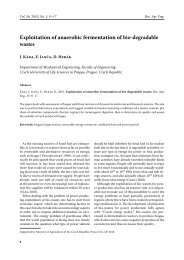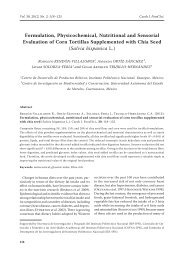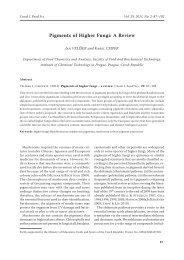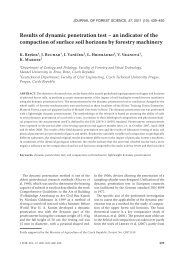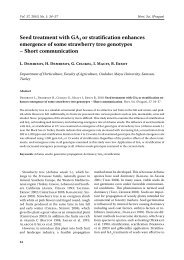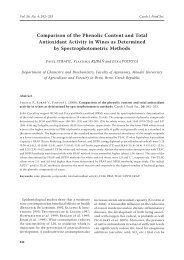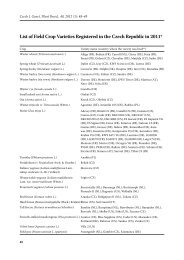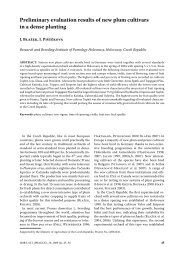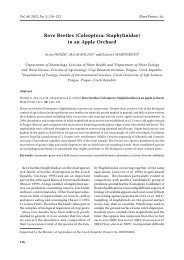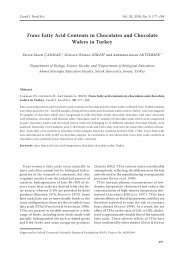The Viral Etiology of Tomato Yellow Leaf Curl Disease – A Review
The Viral Etiology of Tomato Yellow Leaf Curl Disease – A Review
The Viral Etiology of Tomato Yellow Leaf Curl Disease – A Review
Create successful ePaper yourself
Turn your PDF publications into a flip-book with our unique Google optimized e-Paper software.
Vol. 45, 2009, No. 3: 81<strong>–</strong>97 Plant Protect. Sci.<br />
many aspects <strong>of</strong> the disease, the causative viruses<br />
and their vector. Nevertheless, accumulation <strong>of</strong><br />
more new data on the biology <strong>of</strong> TYLCV and new<br />
reports on its spread, as well as recent reports on<br />
the introduction <strong>of</strong> new approaches to combating<br />
TYLCV epidemics, contribute to the timeliness<br />
<strong>of</strong> this review.<br />
84<br />
2. Economic impact<br />
Reductions in tomato crop value have been associated<br />
with tomato yellow leaf curl disease (TYLCD)<br />
since it was first described by Avidov in the late<br />
1930s in Israel, in association with outbreaks <strong>of</strong> the<br />
whitefly Bemisia tabaci [Avidov (Klein) 1940].<br />
Twenty years later, in 1959, an entire tomato crop<br />
was destroyed by a disease with TYLCV-like symptoms<br />
in the Jordan Valley (Cohen & Antignus<br />
1994). Cohen & Harpaz (1964) published the<br />
first description <strong>of</strong> this new disease, transmitted<br />
by B. tabaci. It has since become an economically<br />
important disease, spreading, during the second<br />
half <strong>of</strong> the 20 th century, to all <strong>of</strong> the countries in<br />
the Mediterranean basin, as well as Africa, Asia<br />
and the New World (Table 1).<br />
Around 7 million hectares <strong>of</strong> crop plants in<br />
40 countries are subjected to begomovirus attack<br />
by TYLCV or by mixed infections in 15 <strong>of</strong> those<br />
countries (Martinez et al. 2003). <strong>The</strong> treatment<br />
in industrial countries includes mainly the use<br />
<strong>of</strong> insecticides against the insect vector and the<br />
introduction <strong>of</strong> more tolerant crop varieties. <strong>The</strong><br />
implementation <strong>of</strong> physical barriers and growing<br />
tomatoes under greenhouse conditions has also<br />
cut the damage to an average 20%, conservatively<br />
estimated at more than $300 million, in Europe and<br />
Figure 1. TYLCV-induced disease symptoms on<br />
tomato plants. Note the pale color <strong>of</strong> the upper<br />
young leaves (right side arrow) as well as some<br />
curling (left side arrow)<br />
the US (Gianessi et al. 2002, 2003). <strong>The</strong> situation<br />
is much worse in developing countries, where the<br />
use <strong>of</strong> hybrid seeds and insecticides, as well as the<br />
practice <strong>of</strong> growing tomatoes only in greenhouses,<br />
are not options due to their high cost.<br />
3. Virus structure<br />
Like all other known members <strong>of</strong> the Geminiviridae,<br />
TYLCV is a small DNA virus characterised by<br />
its unique capsid morphology, which consists <strong>of</strong><br />
double incomplete icosahedral virions (Figure 2).<br />
<strong>The</strong> TYLCV coat protein (CP) encapsidates a sin-<br />
Bar = 100 nm (Courtesy <strong>of</strong> Katharina Kittelmann)<br />
Figure 2. Electron microscopy image <strong>of</strong> purified begomovirus<br />
particles




